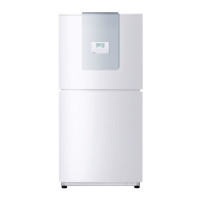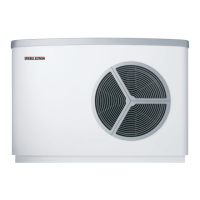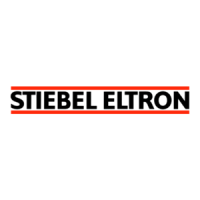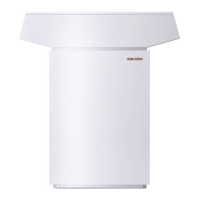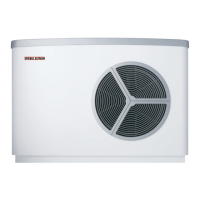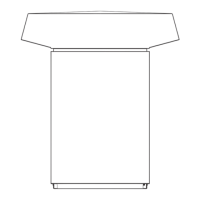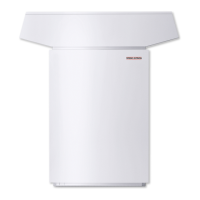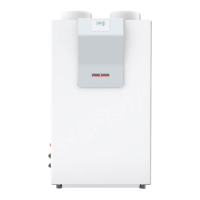12
Heating curve adjustment
Adjust the heating curve carefully, as the
heat pump efficiency will be reduced with an
increasing flow temperature. Heating curves,
which are adjusted too high, lead to the zone
and thermostatic valves closing, which may
lead to the minimum flow rate required for
the heat pump not being achieved.
Procedure for selecting the correct heating
curve:
Fully open the thermostatic valve(s) or zone
valve(s) in the lead room, e.g. in the living
room or bathroom (remove the head of
thermostatic valves) and match the heating
curve at different outside temperatures (e.g.
– 10 °C and + 10 °C), so that the required
temperature results in the lead room. The
thermostatic valve(s) or zone valve(s) in the
lead room should always be fully open (Stiebel
Eltron recommends, that the heating circuit of
the lead room is installed without thermostatic
or zone valves, and to achieve the individual
room control via a remote control unit).
Standard values for an initial start:
Parameter Underfloor
heating
system
Heating
system with
radiators
Heating curve 0.4 0.8
Controller
dynamics
515
Room temp. 20 °C 20 °C
Match the heating curve as follows:Increase
the room temperature parameter, if the room
temperature in spring and autumn is too low
(approx. 10 °C outside temperature). Providing
no remote control is installed, this will lead to
a parallel offset of the heating curve. Increase
the heating curve parameter, if the room
temperature is not high enough when outside
temperatures are low. Then adjust the zone
valve or thermostatic valve to the required
temperature.
Never reduce the temperature in the entire
building by closing all zone or thermostatic
valves, but by using the setback programs.
DHC heater connection
The second heat source (DHC heater), which
is integrated into the heat pump, must be
connected.
For optimum function of the WPL 10 A/I/
IK connect all three stages (8.8 kW) and for
optimum function of the WPL 7 AS/IKS connect
two stages (6.2 kW).
Other WPM II adjustments
Activate the constant buffer primary pump
operation at the WPM II, and connect the
heating circuit pump to the buffer primary
cylinder pump terminal.
3.7 Heat source 2
For dual-mode systems, always connect the
heat pump into the return of the second heat
source (e.g. oil fired boiler).
3.8 Removing the casing parts
The side panels, the front and back panels
are hooked into the heat pump frame and are
secured at the centre (bottom) of each panel
respectively with one quick-acting screw. After
removing the quick-acting screw, the casing
panels can be pushed up and can be removed.
With the WPL....IK / IKS, only the lower casing
panels can be removed.
3.9 Installing the air hoses
3.9.1 WPL....I
Air hoses guide the inlet air from the outside
to the heat pump and route the extract air
from the heat pump to the outdoors. These
hoses are highly flexible, thermally insulated
and are self-extinguishing in case of fire in
accordance with ASTMD 1692-67 T.
Thermally insulated air hoses are available in
lengths of 4 m (for part no., see section 1.6).
Information regarding routing the air hoses
Use a sharp knife for trimming the hoses to
size; use a wire cutter for cutting through the
Bowden core.
Hoses can be extended by turning the Bowden
cores into each other
(approx. 30 cm).
The total length of hoses on the air inlet and
outlet side must not exceed 8 m.
Install no more than four 90° bends with a
radius of at least 600 mm, relative to the hose
centre line.
The air hoses will tend to sag because of
their flexibility; therefore support their length
approx. every 1 m.
Fitting the air hoses to the WPL....I and the
outside wall of the building
Match the air hose ends to the shape of the
oval connectors at the cover and the hose
connection plates. Hose connection plates are
available as accessory (part no. see section 1.6).
Initially withdraw the internal hoses slightly,
push over the connectors and seal with
adhesive tape (supplied with the cover). Then
pull the exterior hoses forward, and secure
them well with the oval hose clips, which are
also supplied with the cover
(see Fig. 3
).
Always cover the air inlet and outlet
apertures with wire grilles, and
secure the hoses against slippage.
3.9.2 WPL....IK / IKS and securing the air hoses
at the outside wall of the building
Secure the ready-made air hoses with the
wing nuts (M5) contained in the pack to the
heat pump (see Fig. 4).
Subject to wall structure, use suitable rawl
plugs and screws to fix the wall mounted
connecting plates.
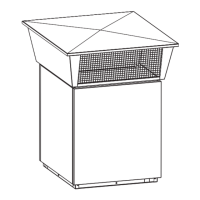
